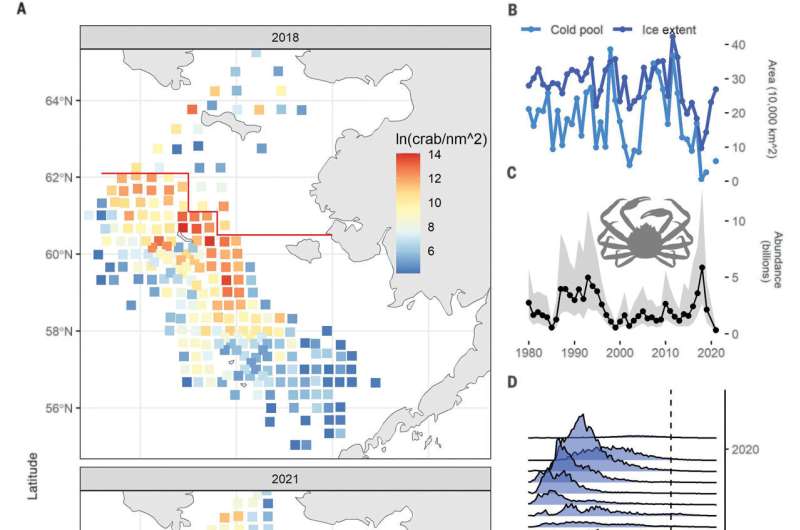October 20, 2023 report
This article has been reviewed according to Science X's editorial process and policies. Editors have highlighted the following attributes while ensuring the content's credibility:
fact-checked
peer-reviewed publication
trusted source
proofread
Why 10 billion snow crabs starved to death in the Bering Sea

A team of marine biologists with the U.S. National Oceanic and Atmospheric Administration's Alaska Fishery Science Center has solved the mystery of why approximately 10 billion snow crabs vanished from the Bering Sea back in 2018/2019—the water there was too warm for them.
In their study, reported in the journal Science, the group used data from previous studies on the way snow crabs respond to warmer temperatures to solve the mystery. Gordon Kruse, a member of the North Pacific Research Board, has published a Perspective piece in the same journal issue outlining the events that surrounded the population crash of the snow crabs and the work done by the team on this new effort to find out why.
Snow crabs are relatively small crabs, that, despite their name, are not white—they are red, like lobsters. They live on the ocean floor in shallow areas and have been consumed as a seafood delicacy for many years.
Alaskan fishermen (and scientists) first noticed a dramatic decline in their numbers back in 2021. Then, due to the pandemic, fishing and studying of the crabs was put on hiatus for a year. The full extent of the crab disappearance was only observed earlier in 2023—over 10 billion were missing. Upon discovering this alarming decline, a research team set to work to figure out what happened.
The team started by scouting nearby areas, hoping that the crabs had simply moved to another location, but no sign of them could be found.
Next, noting that the area had experienced a heat wave prior to, and during, the crab disappearance they turned to the results of a prior study that had found that when water temperatures increase, energy requirements for the crabs increase. The researchers found that if water temperatures increased by just 3°C, the caloric needs of the crabs doubled.
Records showed that during the heat wave, water temperatures had risen 3°C, which meant the crabs would have needed twice as much food to sustain themselves. The research team also found that just prior to the heat wave, the crab population had risen dramatically, meaning that there had been a large increase in competition for food. And that, the researchers conclude, led the crabs to starve to death.
More information: Cody S. Szuwalski et al, The collapse of eastern Bering Sea snow crab, Science (2023). DOI: 10.1126/science.adf6035
Gordon H. Kruse, Are crabs in hot water?, Science (2023). DOI: 10.1126/science.adk7565
Journal information: Science
© 2023 Science X Network




















